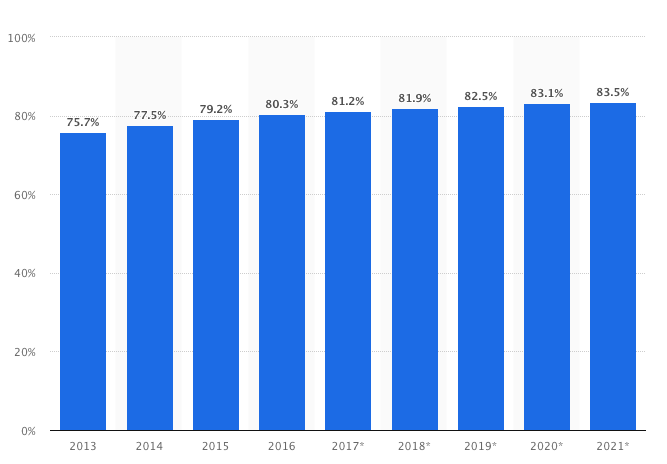Video streaming was once something only the most high-tech folks did while the rest of us paid for cable and rented movies at Redbox. Today, streaming is one of the most popular ways to discover and view television shows, movies, work out videos, and music. Some of today’s common streaming services include Netflix, iTunes, Amazon, YouTube, Hulu, and Vimeo. These services allow viewers to access a wide variety of online content from their smartphones, tablets, laptops, and televisions.
Video streaming has quickly gone from cutting-edge to mainstream. With 71% of the US population streaming video, chances are you or someone you know streams video on a daily basis.
Digital video penetration in the United States from 2013 to 2021
Source – Statista
The reasons for the inclusion of streaming as a content source may vary. The number one reason across all age demographics is the vast amount of content available on-demand, including a significant amount of original content being developed and distributed by providers such as Netflix, Hulu, and Amazon.
Many use video streaming to replay television episodes or to check out original content recommended by friends and family. While some love streaming because it gives them the opportunity to binge watch entire seasons, or save money on paying for cable. Video streaming challenges traditional media advertising as consumers can and often do skip commercials. They are bombarded with advertising in their daily lives from car and bus wraps to billboards and digital displays. How does one cut through all of this noise?
The opportunity with streaming is that the target audience can be much more effectively reached with the extensive amount of unique programming. Brands are able to negotiate product placement within episodes or sponsor behind the scenes features, making them more credible and better aligned with the viewer’s values.
Beyond being able to know which shows and movies are currently trending, one can look beyond the mainstream audience into niches, allowing for a greater ROI with less expensive, more specifically targeted advertising and promotion.
What devices are they using to access this content? Alongside video streaming services, there are those who access their digital content through cable television services with their platforms, such as HBO and Showtime. Plus, many of these services are funded by subscription rather than relying upon advertising. The question then becomes not only, how do people learn about new television shows or movies, but how do we reach them with new products and services? Is it strictly about sponsorship or product placement? Is broadcast advertising becoming a thing of the past? Are their opportunities to advertise on fan sites or social media pages working directly with the studio?
As a starting point, there is an abundance of data ready for analysis based on ease of direct racking as well insights gathered by more traditional methods to show us how, why, and via which platforms consumers use to stream their digital content through to where they go to learn more, purchase related merchandise, or discuss episodes and scenes.
While the companies distributing this new array of content use these insights to provide their audiences with quality content targeted to their interests while enhancing the user’s experience overall, as marketers, this information allows us to best reach our own consumers.
Authors: Omar Gutierrez and Morgan Ward
To learn more about how marketers are changing the way they reach their target consumers, come check out our next event Emerging Trends In Communications.










Comments are closed.